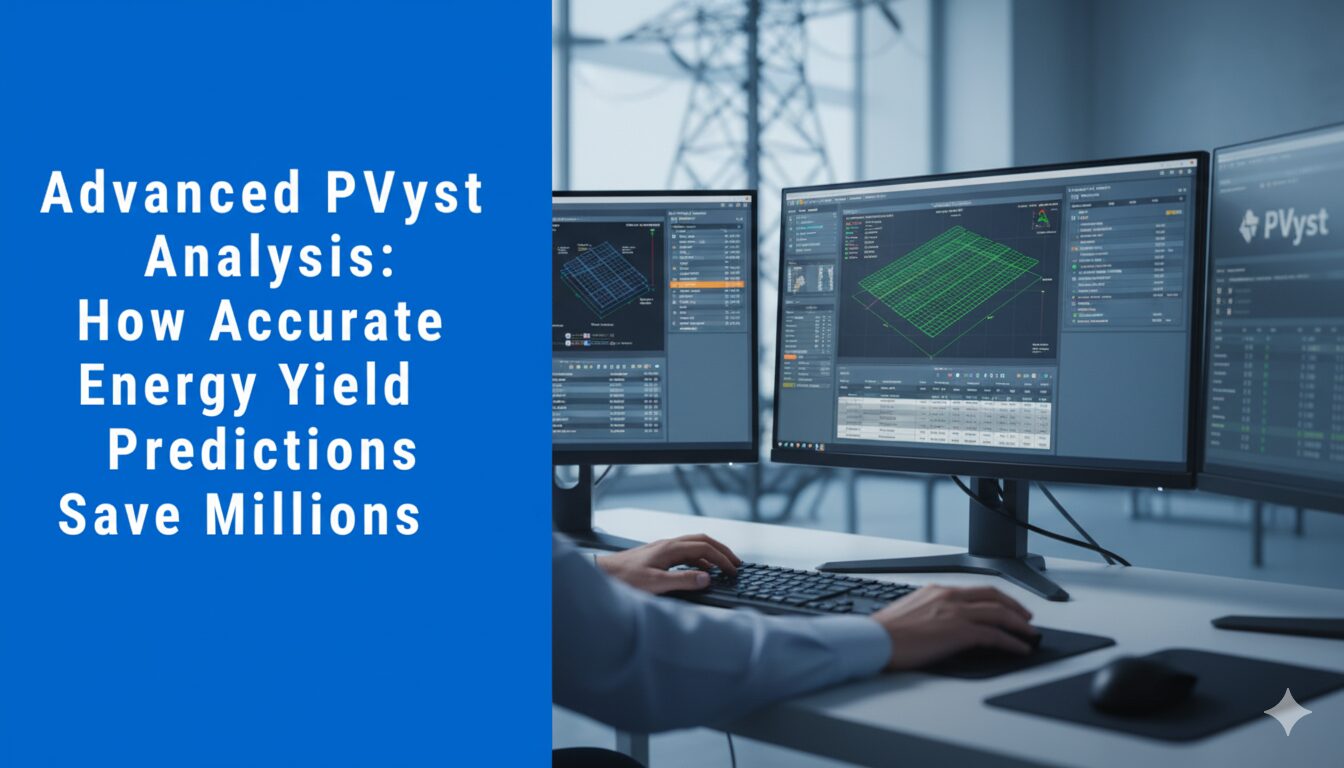Introduction
When you build a solar plant, every single number matters. Energy yield predictions are not just figures in a simulation report—they’re the foundation on which financing, investor trust, and project decisions stand. A difference of just 1% in annual yield estimates can translate into millions of rupees gained or lost over a plant’s lifetime.
This is where PVsyst comes in. It has become the go-to software for energy yield assessment in the solar industry. But here’s the catch: while most blogs stop at showing how PVsyst works, the real story is about how accurate these predictions are and how developers can refine them further. That’s what we’ll dive into today—advanced PVsyst analysis, validation with real-world data, and why better accuracy means stronger profits and lower risks.
Why Accurate Yield Predictions Are the Backbone of Solar Projects
Energy yield forecasts influence almost every stage of a solar project:
- Financing – Banks rely on these predictions to assess repayment capacity.
- Investor confidence – Accurate numbers make investors more willing to commit.
- Contracts – EPC and O&M agreements often tie penalties or bonuses to plant performance.
- Cash flows – A small error compounds into huge differences across 20–25 years of operation.
For example, consider a 100 MW solar farm projected to generate 200 GWh per year. If your prediction is off by just 1%, you’re short by 2 GWh. At INR 5 per unit, that’s INR 10 crore lost in a decade. In short, accuracy is money.
How PVsyst Traditionally Works
PVsyst is powerful, but by default, it gives you a deterministic outcome—a single number. This is usually based on:
- Long-term meteorological datasets (TMY)
- Fixed assumptions for soiling, mismatch, shading, and temperature effects
- Module and inverter parameters
That number, often referred to as P50, is widely accepted. But it doesn’t reflect the uncertainties that real projects face—like weather variability, degradation, or unforeseen losses. That’s where advanced analysis comes into play.
Taking PVsyst to the Next Level
1. Monte Carlo Simulations: Capturing Uncertainty
Real life doesn’t follow one neat number. That’s why Monte Carlo simulations are a game-changer. Instead of sticking to fixed assumptions, they run hundreds of simulations, each varying inputs like irradiance, temperature, and losses within realistic ranges.
What you get is not a single yield but a distribution of outcomes—from worst case (P10) to conservative (P90) to expected (P50). Investors love this because it gives them clarity about risks.
📌 In fact, a global study covering 26 PV plants showed that when PVsyst used Monte Carlo methods, the predicted ranges matched observed outputs very closely (IEA PVPS Report).
2. What Real-World Studies Show
Researchers have tested PVsyst against actual operating plants, and the findings are promising:
- Spain, Italy, Chile – PVsyst slightly underestimated fixed system yields. In one Chilean project, the error was as small as –0.74% (d-nb.info).
- Global sites (India, China, US, Mexico, Chile, Argentina) – Simulations using hourly data vs synthetic datasets showed just a ~2% variation, proving PVsyst’s consistency across climates (Vaisala White Paper).
- UK rooftop plant – Integrating real-time meteorological data improved accuracy by 6–9% and helped identify the best tilt and azimuth angles for maximum generation (MDPI Research).
These studies confirm that PVsyst is reliable, but also highlight that fine-tuning inputs and using advanced methods significantly improves precision.
3. Operational Insights You Can Gain
Advanced PVsyst analysis isn’t just about accuracy—it’s also about smarter design decisions:
- Tilt and orientation – Studies suggest that for certain regions, a 35–39° tilt with 0° azimuth provided ~646 kWh/m² per month.
- Shading analysis – Proper 3D modeling prevents overestimations since shading can eat up 10% or more of yield if not factored in.
- Live weather integration – Feeding real-time irradiance and temperature data into PVsyst improves forecasting and helps O&M teams take proactive steps.
Why Accuracy Equals Financial Security
Let’s put the numbers into perspective again:
- Project size: 100 MW
- Expected annual generation: 200 GWh
- Prediction error: 1% = 2 GWh
- Revenue impact: INR 1 crore annually, INR 20 crore over 20 years
That’s the cost of ignoring advanced modeling. But if developers adopt uncertainty ranges (P50/P90), integrate high-quality data, and validate post-commissioning, they build bankable projects with fewer disputes and stronger long-term profits.
Best Practices for Using PVsyst Like a Pro
- Don’t rely only on generic TMY data—get high-resolution local measurements.
- Always run Monte Carlo simulations to see probability ranges (P10–P90).
- Use realistic assumptions for degradation, soiling, and mismatch losses.
- Validate against real generation data once the plant is operational.
- Report with transparency—show uncertainty bands, not just one yield value.
- Integrate SCADA and weather feeds to keep refining forecasts.
Conclusion
If there’s one lesson here, it’s this: accuracy pays for itself. Developers who take the extra step with advanced PVsyst analysis—whether by running Monte Carlo simulations, integrating real-time data, or validating with real plant results—aren’t just being technically thorough. They’re protecting millions in future revenue and ensuring investor confidence.
In the world of solar, where margins are slim and expectations are high, a 1% improvement isn’t just a technical win—it’s a financial strategy that can decide whether a project thrives or struggles.


